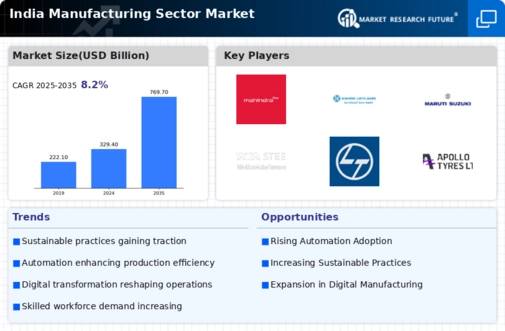Robust Economic Growth
The Global India Manufacturing Sector Market Industry is poised for substantial growth, driven by India's robust economic performance. In 2024, the market is valued at approximately 235.94 USD Billion, reflecting the country's increasing industrial output and investment in manufacturing capabilities. The government's initiatives, such as 'Make in India', aim to enhance the manufacturing sector's contribution to GDP, which is projected to rise significantly. This economic momentum is likely to attract foreign direct investment, further bolstering the sector's expansion and competitiveness on a global scale.
Growing Domestic Demand
The Global India Manufacturing Sector Market Industry is bolstered by the increasing domestic demand for various products, driven by a burgeoning middle class and urbanization. As consumer preferences evolve, there is a rising need for diverse goods, from electronics to automobiles. This domestic consumption is expected to fuel production capabilities, prompting manufacturers to scale operations. The anticipated growth in the market, reaching 541.32 USD Billion by 2035, suggests that companies will need to adapt to changing consumer behaviors and invest in innovative products to meet the demands of an expanding market.
Technological Advancements
Technological innovation plays a pivotal role in the Global India Manufacturing Sector Market Industry, as companies increasingly adopt automation and smart manufacturing practices. The integration of Industry 4.0 technologies, such as IoT and AI, enhances operational efficiency and productivity. For instance, manufacturers are leveraging data analytics to optimize supply chains and reduce costs. This trend is expected to accelerate growth, with the market projected to reach 541.32 USD Billion by 2035. As firms invest in cutting-edge technologies, they position themselves competitively in the global landscape, potentially leading to higher market shares.
Government Initiatives and Policies
The Global India Manufacturing Sector Market Industry benefits significantly from proactive government policies aimed at fostering industrial growth. Initiatives like 'Atmanirbhar Bharat' promote self-reliance in manufacturing, encouraging local production and reducing dependency on imports. These policies are designed to enhance the ease of doing business, streamline regulations, and provide financial incentives for manufacturers. As a result, the sector is likely to experience a compound annual growth rate of 7.84% from 2025 to 2035, indicating a strong commitment to developing a sustainable manufacturing ecosystem that can compete globally.
Sustainability and Green Manufacturing
Sustainability has emerged as a critical driver in the Global India Manufacturing Sector Market Industry, with manufacturers increasingly adopting eco-friendly practices. The shift towards green manufacturing not only addresses environmental concerns but also enhances brand reputation and compliance with global standards. Companies are investing in renewable energy sources and sustainable materials to minimize their carbon footprint. This trend is likely to resonate with consumers and investors alike, potentially leading to increased market share and profitability. As sustainability becomes a core business strategy, the sector is expected to thrive in a competitive global environment.














Leave a Comment